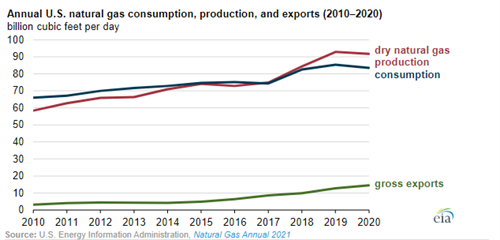EIA:U.S. natgas consumption and production decreased, exports grew in 2020

U.S. natural gas production and consumption decreased in 2020 because of mild winter weather and the COVID-19 pandemic's effect on demand, according to our recently released Natural Gas Annual. Less natural gas was consumed in the U.S., which pushed prices down; the annual Henry Hub spot price for 2020 averaged $2.03/MMBtu, the lowest annual price since 1997. The low prices contributed to record-high levels of natural gas exports and consumption in the electric power sector in 2020.

Natural gas consumption in the largest U.S. consuming sector—electric power—rose by 3% in 2020. Low prices made natural gas a more competitive fuel for generation, particularly compared with coal. Natural gas-fired generation capacity has been increasing in recent years, replacing coal-fired capacity as it retires. Natural gas accounted for 39% of all power generation in 2020, nearly equal to the shares of coal and nuclear, the next two largest sources, combined. We expect the share of natural gas-fired generation to decrease in 2021 because of higher natural gas prices.
This change may result in coal accounting for an increased share of power generation in 2021, its first year-over-year increase since 2013. We expect U.S. natural gas consumption in 2022 to increase slightly from 2021, as increasing consumption in the industrial sector offsets declining consumption in the electric power sector, but to still remain lower than the 2020 level.
Natural gas consumption in three of the four major U.S. consuming sectors decreased between 2019 and 2020, but the commercial sector decreased the most in percentage terms. The winter months of 2020 (January–March and November–December) were milder than in the previous two years, which resulted in a 7% decrease in heating demand in the residential sector and an 11% decrease in the commercial sector. Industrial sector demand decreased by 3% amid a weakening economy in 2020. The industrial and commercial sectors consumed less natural gas largely because of COVID-19-related closures and reduced usage of facilities.
Total U.S. natural gas exports (net exports) rose by 13% in 2020, primarily because of increased pipeline exports to Mexico and record-high LNG exports at the beginning and end of 2020. U.S. natural gas net exports have increased each year since 2007.

Despite a 1% decrease in dry natural gas production in 2020, dry natural gas production levels remained high. Low natural gas and crude oil prices curbed production of associated gas (natural gas that is produced as a byproduct of oil production), driving the first year-over-year decline in associated gas production in Texas since 2016. In 2020, of the two states with the most natural gas production, Texas saw its dry natural gas production decline by 0.5 Bft3/d to average 21.8 Bft3/d. Pennsylvania dry natural gas production increased by 0.6 Bft3/d to average 19.3 Bft3/d.

- ExxonMobil halts 1-Bft3d blue hydrogen project in Texas
- Aramco and Yokogawa commission multiple autonomous control AI agents at Fadhili gas plant
- Ukraine will resume gas imports via Transbalkan route in November
- Mitsubishi to inject $260 MM into Brunei LNG project
- Freeport LNG (U.S.) on track to take in more natgas on Thursday after unit outage



Comments